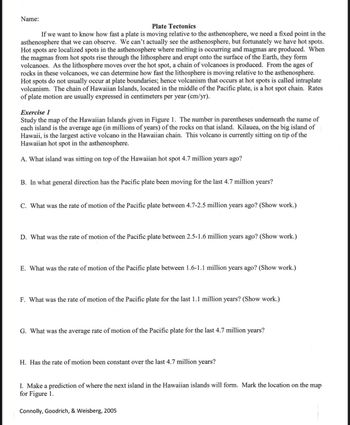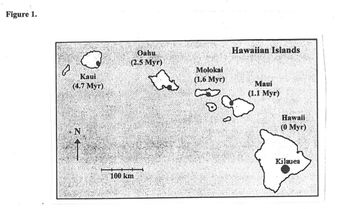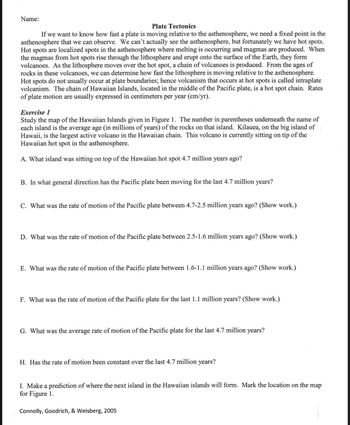A. What island was sitting on top of the Hawaiian hot spot 4.7 million years ago? B. In what general direction has the Pacific plate been moving for the last 4.7 million years?
A. What island was sitting on top of the Hawaiian hot spot 4.7 million years ago? B. In what general direction has the Pacific plate been moving for the last 4.7 million years?
Applications and Investigations in Earth Science (9th Edition)
9th Edition
ISBN:9780134746241
Author:Edward J. Tarbuck, Frederick K. Lutgens, Dennis G. Tasa
Publisher:Edward J. Tarbuck, Frederick K. Lutgens, Dennis G. Tasa
Chapter1: The Study Of Minerals
Section: Chapter Questions
Problem 1LR
Related questions
Question
100%
Answer question #1 and #2

Transcribed Image Text:Plate Tectonics
If we want to know how fast a plate is moving relative to the asthenosphere, we need a fixed point in the
asthenosphere that we can observe. We can't actually see the asthenosphere, but fortunately we have hot spots.
Hot spots are localized spots in the asthenosphere where melting is occurring and magmas are produced. When
the magmas from hot spots rise through the lithosphere and erupt onto the surface of the Earth, they form
volcanoes. As the lithosphere moves over the hot spot, a chain of volcanoes is produced. From the ages of
rocks in these volcanoes, we can determine how fast the lithosphere is moving relative to the asthenosphere.
Hot spots do not usually occur at plate boundaries; hence volcanism that occurs at hot spots is called intraplate
volcanism. The chain of Hawaiian Islands, located in the middle of the Pacific plate, is a hot spot chain. Rates
of plate motion are usually expressed in centimeters per year (cm/yr).
Exercise 1
Study the map of the Hawaiian Islands given in Figure 1. The number in parentheses underneath the name of
each island is the average age (in millions of years) of the rocks on that island. Kilauea, on the big island of
Hawaii, is the largest active volcano in the Hawaiian chain. This volcano is currently sitting on tip of the
Hawaiian hot spot in the asthenosphere.
A. What island was sitting on top of the Hawaiian hot spot 4.7 million years ago?
B. In what general direction has the Pacific plate been moving for the last 4.7 million years?

Transcribed Image Text:Figure 1.
(
Kaui
(4.7 Myr)
N
Oahu
(2.5 Myr)
100 km
Molokai
(1.6 Myr)
Hawaiian Islands
Maui
(1.1 Myr)
Hawaii
(0 Myr)
Kilauea
Expert Solution
This question has been solved!
Explore an expertly crafted, step-by-step solution for a thorough understanding of key concepts.
This is a popular solution!
Trending now
This is a popular solution!
Step by step
Solved in 3 steps with 3 images

Follow-up Questions
Read through expert solutions to related follow-up questions below.
Follow-up Question
G and H only.

Transcribed Image Text:Name:
Plate Tectonics
If we want to know how fast a plate is moving relative to the asthenosphere, we need a fixed point in the
asthenosphere that we can observe. We can't actually see the asthenosphere, but fortunately we have hot spots.
Hot spots are localized spots in the asthenosphere where melting is occurring and magmas are produced. When
the magmas from hot spots rise through the lithosphere and erupt onto the surface of the Earth, they form
volcanoes. As the lithosphere moves over the hot spot, a chain of volcanoes is produced. From the ages of
rocks in these volcanoes, we can determine how fast the lithosphere is moving relative to the asthenosphere.
Hot spots do not usually occur at plate boundaries; hence volcanism that occurs at hot spots is called intraplate
volcanism. The chain of Hawaiian Islands, located in the middle of the Pacific plate, is a hot spot chain. Rates
of plate motion are usually expressed in centimeters per year (cm/yr).
Exercise 1
Study the map of the Hawaiian Islands given in Figure 1. The number in parentheses underneath the name of
each island is the average age (in millions of years) of the rocks on that island. Kilauea, on the big island of
Hawaii, is the largest active volcano in the Hawaiian chain. This volcano is currently sitting on tip of the
Hawaiian hot spot in the asthenosphere.
A. What island was sitting on top of the Hawaiian hot spot 4.7 million years ago?
B. In what general direction has the Pacific plate been moving for the last 4.7 million years?
C. What was the rate of motion of the Pacific plate between 4.7-2.5 million years ago? (Show work.)
D. What was the rate of motion of the Pacific plate between 2.5-1.6 million years ago? (Show work.)
E. What was the rate of motion of the Pacific plate between 1.6-1.1 million years ago? (Show work.)
F. What was the rate of motion of the Pacific plate for the last 1.1 million years? (Show work.)
G. What was the average rate of motion of the Pacific plate for the last 4.7 million years?
H. Has the rate of motion been constant over the last 4.7 million years?
I. Make a prediction of where the next island in the Hawaiian islands will form. Mark the location on the map
for Figure 1.
Connolly, Goodrich, & Weisberg, 2005

Transcribed Image Text:Figure 1.
(
Kaui
(4.7 Myr)
N
Oahu
(2.5 Myr)
100 km
Molokai
(1.6 Myr)
Hawaiian Islands
Maui
(1.1 Myr)
Hawaii
(0 Myr)
Kilauea
Solution
Follow-up Question
C and D only.

Transcribed Image Text:Name:
Plate Tectonics
If we want to know how fast a plate is moving relative to the asthenosphere, we need a fixed point in the
asthenosphere that we can observe. We can't actually see the asthenosphere, but fortunately we have hot spots.
Hot spots are localized spots in the asthenosphere where melting is occurring and magmas are produced. When
the magmas from hot spots rise through the lithosphere and erupt onto the surface of the Earth, they form
volcanoes. As the lithosphere moves over the hot spot, a chain of volcanoes is produced. From the ages of
rocks in these volcanoes, we can determine how fast the lithosphere is moving relative to the asthenosphere.
Hot spots do not usually occur at plate boundaries; hence volcanism that occurs at hot spots is called intraplate
volcanism. The chain of Hawaiian Islands, located in the middle of the Pacific plate, is a hot spot chain. Rates
of plate motion are usually expressed in centimeters per year (cm/yr).
Exercise 1
Study the map of the Hawaiian Islands given in Figure 1. The number in parentheses underneath the name of
each island is the average age (in millions of years) of the rocks on that island. Kilauea, on the big island of
Hawaii, is the largest active volcano in the Hawaiian chain. This volcano is currently sitting on tip of the
Hawaiian hot spot in the asthenosphere.
A. What island was sitting on top of the Hawaiian hot spot 4.7 million years ago?
B. In what general direction has the Pacific plate been moving for the last 4.7 million years?
C. What was the rate of motion of the Pacific plate between 4.7-2.5 million years ago? (Show work.)
D. What was the rate of motion of the Pacific plate between 2.5-1.6 million years ago? (Show work.)
E. What was the rate of motion of the Pacific plate between 1.6-1.1 million years ago? (Show work.)
F. What was the rate of motion of the Pacific plate for the last 1.1 million years? (Show work.)
G. What was the average rate of motion of the Pacific plate for the last 4.7 million years?
H. Has the rate of motion been constant over the last 4.7 million years?
I. Make a prediction of where the next island in the Hawaiian islands will form. Mark the location on the map
for Figure 1.
Connolly, Goodrich, & Weisberg, 2005

Transcribed Image Text:Figure 1.
(
Kaui
(4.7 Myr)
N
Oahu
(2.5 Myr)
100 km
Molokai
(1.6 Myr)
Hawaiian Islands
Maui
(1.1 Myr)
Hawaii
(0 Myr)
Kilauea
Solution
Recommended textbooks for you

Applications and Investigations in Earth Science …
Earth Science
ISBN:
9780134746241
Author:
Edward J. Tarbuck, Frederick K. Lutgens, Dennis G. Tasa
Publisher:
PEARSON

Exercises for Weather & Climate (9th Edition)
Earth Science
ISBN:
9780134041360
Author:
Greg Carbone
Publisher:
PEARSON

Environmental Science
Earth Science
ISBN:
9781260153125
Author:
William P Cunningham Prof., Mary Ann Cunningham Professor
Publisher:
McGraw-Hill Education

Applications and Investigations in Earth Science …
Earth Science
ISBN:
9780134746241
Author:
Edward J. Tarbuck, Frederick K. Lutgens, Dennis G. Tasa
Publisher:
PEARSON

Exercises for Weather & Climate (9th Edition)
Earth Science
ISBN:
9780134041360
Author:
Greg Carbone
Publisher:
PEARSON

Environmental Science
Earth Science
ISBN:
9781260153125
Author:
William P Cunningham Prof., Mary Ann Cunningham Professor
Publisher:
McGraw-Hill Education

Earth Science (15th Edition)
Earth Science
ISBN:
9780134543536
Author:
Edward J. Tarbuck, Frederick K. Lutgens, Dennis G. Tasa
Publisher:
PEARSON

Environmental Science (MindTap Course List)
Earth Science
ISBN:
9781337569613
Author:
G. Tyler Miller, Scott Spoolman
Publisher:
Cengage Learning

Physical Geology
Earth Science
ISBN:
9781259916823
Author:
Plummer, Charles C., CARLSON, Diane H., Hammersley, Lisa
Publisher:
Mcgraw-hill Education,